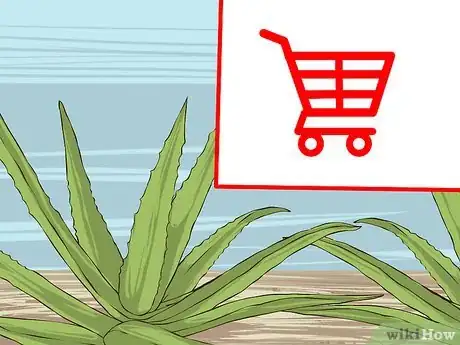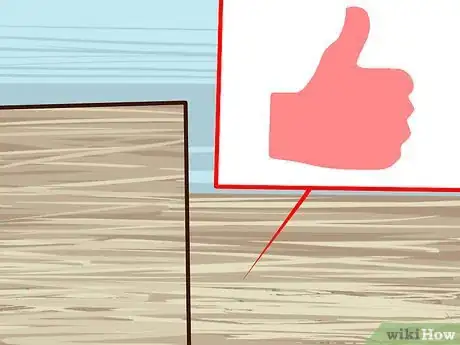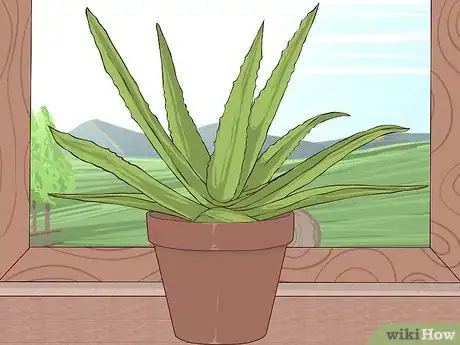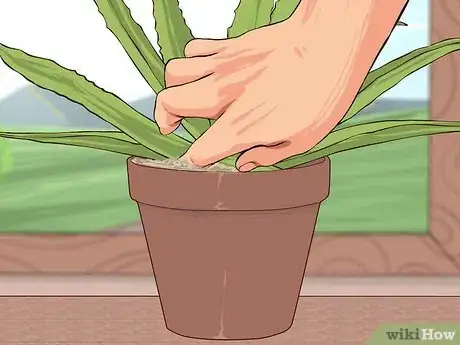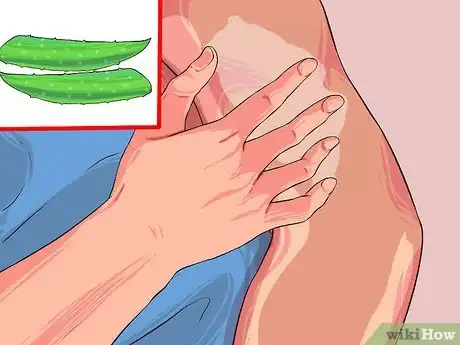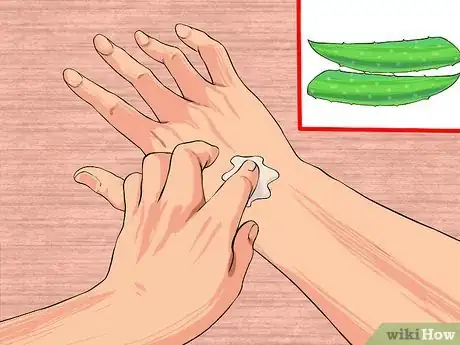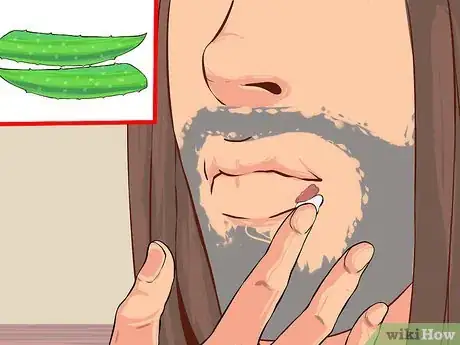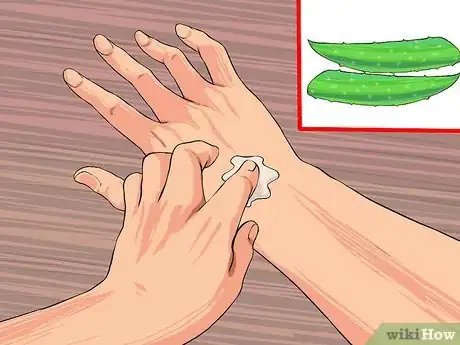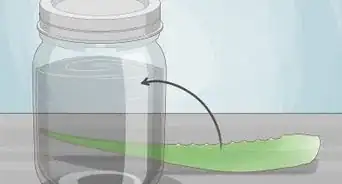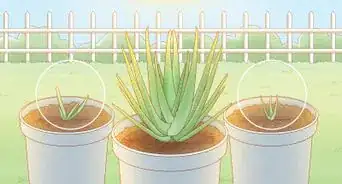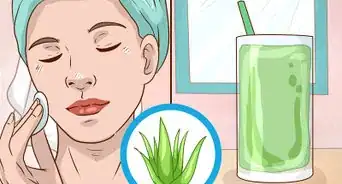This article was co-authored by Zora Degrandpre, ND. Dr. Zora Degrandpre is a Natural Health Doctor and Licensed Naturopathic Physician in Vancouver, Washington. She is a grant reviewer for the National Institutes of Health and the National Center for Complementary and Alternative Medicine. She received her ND from the National College of Natural Medicine in 2007.
There are 9 references cited in this article, which can be found at the bottom of the page.
wikiHow marks an article as reader-approved once it receives enough positive feedback. In this case, 89% of readers who voted found the article helpful, earning it our reader-approved status.
This article has been viewed 314,719 times.
Aloe vera, also known as medicinal aloe, is a species of succulent plant that thrives in dry, hot regions of the world. Aloe vera is a stemless or very short-stemmed succulent plant that can grow as high as three feet tall. The leaves are thick and fleshy, green to grey-green, with some varieties showing white flecks on the upper and lower stem surfaces. Yellow flowers may grow on outdoor aloe plants, but not on indoor potted aloe plants.[1] Aloe vera sap from the plants may be useful in the treatment of wound and burn healing, skin dryness, and even cold sores.[2] Keep reading to learn how to grow and use aloe vera for medicinal purposes.
Steps
Growing Aloe Vera
-
1Purchase an aloe vera plant. Purchase a small plant from a garden store and then repot it in a larger container. If you care for the plant properly, it will thrive and produce plenty of aloe for medicinal use.
- Choose a wide container to repot your aloe plant since aloes tend to produce offshoots, or baby aloe plants.
-
2Use appropriate soil. The most important point to remember while using soil for growing Aloe vera plants is that the soil should be moderately fertile and fast draining, as the plant itself contains a lot of water and will wilt if the soil is not fast draining. Use a good quality commercial propagation mix or pre-packaged "cacti and succulent mix" as they allow good drainage.[3]Advertisement
-
3Keep your aloe vera plant in full sun. If you prefer to keep the plant inside, place in a window for maximum sunlight. If you are in mild climatic conditions, take care to provide enough direct light. Artificial light may be used if you do not have much sunlight in your region.[4]
- In areas that receive frost or snow the species is best kept indoors or in heated glasshouses.
-
4Check the soil before you water your aloe vera plant. Stick your finger into the dirt to determine if you plant needs to be watered. Allow the first 1–2 inches (2.5–5.1 cm) of soil to dry out completely between waterings. Since aloe vera plants are native to dry, hot regions, they can survive droughts, but the plants will be more likely to thrive if watered every few days.[5]
- Water your aloe vera plants less in the winter, since the plants will drain more slowly. Over watering can cause rot to form, which may kill your plant.
-
5Repot your plant as needed. When potted aloe plants become crowded with baby plants growing from the sides of the mother plant, they should be divided and re-potted to allow room for further growth and help prevent pest infestations.
- You will have to completely remove your aloe plant from its pot to find these baby plants. Use sharp scissors or a knife to sever them from the mother plant.
- Repot the mother plant when you are finished and transfer each of the baby plants to their own pot.[6]
Using Aloe Vera Gel
-
1Collect aloe gel as needed for medicinal use. Your aloe plant’s leaves are filled with aloe gel that you can harvest as needed for medicinal use. Wait until you need the gel to harvest it. When you need some aloe gel, cut one of the leaves from your aloe plant and squeeze or scoop out the clear aloe gel.
- If you are harvesting a large amount, you may need to cut the leaf in half (lengthwise) in order to get all of the gel out.
- Try to only harvest as much as you need at one time. If you have any leftover gel, you can store it in an airtight container in your refrigerator for up to a week.[7]
-
2Apply aloe after exposure to the sun. You can apply fresh aloe gel to your sunburn to help cool and heal your burn. Apply the gel to your sunburnt skin and reapply ever few hours or as needed to keep your skin moisturized.
- Try refrigerating some aloe gel for an hour or two before applying it to your sunburnt skin. The chilled aloe will have a nice cooling effect.
- Keep in mind that although people have been using aloe as a treatment for sunburns for ages, there is no conclusive scientific research that aloe has a healing effect on sunburnt skin.[8]
-
3Apply aloe vera to minor burns. Aloe may be effective for treating minor burns. It may even reduce healing time. Apply a small amount of the gel to your burn. Do not apply aloe gel to skin that is bleeding, blistered, or otherwise severely damaged.[9]
-
4Massage aloe vera gel into your scalp to prevent dandruff. Aloe vera gel has been found likely to be effective for treating dandruff. All you have to do is massage a small amount of the gel into your scalp.
- After you have washed your hair, rub a small amount of aloe gel between your hands (about the same amount you would use to shampoo your hair).
- Then use your fingertips to massage the gel into your scalp and leave the gel in your hair. Repeat this process each time you wash your hair.[10]
-
5Apply aloe to cold sores. Aloe has been found likely to be effective as a treatment for the herpes virus, also known as cold sores. When you feel a cold sore coming on, get a small amount of aloe gel on your fingertip and dab it onto the sore. Repeat the application as needed to keep the sore covered in aloe gel.[11]
-
6Apply aloe to dry skin. Aloe can also be used as a moisturizer or treatment for dry skin. Try replacing your normal lotion with fresh aloe vera gel. Use the aloe gel the same way that you would use a body lotion. Apply it to the skin all over your body and massage it in until it is absorbed.[12]
Expert Q&A
-
QuestionI eat a tiny bit every morning. It's bitter as can be. Is it safe to eat?
 Zora Degrandpre, NDDr. Zora Degrandpre is a Natural Health Doctor and Licensed Naturopathic Physician in Vancouver, Washington. She is a grant reviewer for the National Institutes of Health and the National Center for Complementary and Alternative Medicine. She received her ND from the National College of Natural Medicine in 2007.
Zora Degrandpre, NDDr. Zora Degrandpre is a Natural Health Doctor and Licensed Naturopathic Physician in Vancouver, Washington. She is a grant reviewer for the National Institutes of Health and the National Center for Complementary and Alternative Medicine. She received her ND from the National College of Natural Medicine in 2007.
Natural Health Doctor You might want to reconsider eating the raw whole leaf-- even a tiny bit. According to the US National Center for Complementary and Integrative Health, oral aloe is associated with a risk of diarrhea and abdominal cramping. Also-- potentially more dangerous is that raw aloe leaf extract has been shown to increase digestive system tumors in lab animals. While it has not been proven to be dangerous in humans, there is a definite risk from eating the raw leaf.
You might want to reconsider eating the raw whole leaf-- even a tiny bit. According to the US National Center for Complementary and Integrative Health, oral aloe is associated with a risk of diarrhea and abdominal cramping. Also-- potentially more dangerous is that raw aloe leaf extract has been shown to increase digestive system tumors in lab animals. While it has not been proven to be dangerous in humans, there is a definite risk from eating the raw leaf. -
QuestionI have heard that using the entire leaf is more beneficial than using only the gel. How much of the entire leaf would I use in a single smoothie?
 Zora Degrandpre, NDDr. Zora Degrandpre is a Natural Health Doctor and Licensed Naturopathic Physician in Vancouver, Washington. She is a grant reviewer for the National Institutes of Health and the National Center for Complementary and Alternative Medicine. She received her ND from the National College of Natural Medicine in 2007.
Zora Degrandpre, NDDr. Zora Degrandpre is a Natural Health Doctor and Licensed Naturopathic Physician in Vancouver, Washington. She is a grant reviewer for the National Institutes of Health and the National Center for Complementary and Alternative Medicine. She received her ND from the National College of Natural Medicine in 2007.
Natural Health Doctor Using the whole leaf should probably be avoided until more evidence comes in regarding the safety of the whole leaf. According to the US National Center for Complementary and Integrative Health (NCCIH), oral aloe is associated with a risk of diarrhea and abdominal cramping. Also-- and this is important, raw aloe leaf extract has been shown to increase digestive tumors in lab animals. While it has not been proven to be dangerous in humans, there is a definite risk from eating the raw leaf.
Using the whole leaf should probably be avoided until more evidence comes in regarding the safety of the whole leaf. According to the US National Center for Complementary and Integrative Health (NCCIH), oral aloe is associated with a risk of diarrhea and abdominal cramping. Also-- and this is important, raw aloe leaf extract has been shown to increase digestive tumors in lab animals. While it has not been proven to be dangerous in humans, there is a definite risk from eating the raw leaf. -
QuestionSome nurseries here have said there's a difference between regular aloe and medicinal aloe. Is this true?
 Zora Degrandpre, NDDr. Zora Degrandpre is a Natural Health Doctor and Licensed Naturopathic Physician in Vancouver, Washington. She is a grant reviewer for the National Institutes of Health and the National Center for Complementary and Alternative Medicine. She received her ND from the National College of Natural Medicine in 2007.
Zora Degrandpre, NDDr. Zora Degrandpre is a Natural Health Doctor and Licensed Naturopathic Physician in Vancouver, Washington. She is a grant reviewer for the National Institutes of Health and the National Center for Complementary and Alternative Medicine. She received her ND from the National College of Natural Medicine in 2007.
Natural Health Doctor Aloe barbadensis (aka. aloe vera) is the type of aloe generally used medicinally. There are over 450 species of Aloe, some of which appear to have similar properties but possibly less effective. Other aloes are poisonous. There are bitter aloes (like Aloe ferox) and very pointy aloes (Aloe acutissima). So, it is true that the medicinal aloe is the aloe vera.
Aloe barbadensis (aka. aloe vera) is the type of aloe generally used medicinally. There are over 450 species of Aloe, some of which appear to have similar properties but possibly less effective. Other aloes are poisonous. There are bitter aloes (like Aloe ferox) and very pointy aloes (Aloe acutissima). So, it is true that the medicinal aloe is the aloe vera.
Warnings
- Although some studies have suggested that oral use of aloe may have some health benefits, these studies have not been confirmed. Currently, taking aloe by mouth is not recommended since some studies have shown that aloe latex, a component in the aloe plant, may cause cancer, kidney failure, and other serious health problems.[14]⧼thumbs_response⧽
- Do not use aloe if you have a known allergy to plants in the Liliaceae (lily) family.[15]⧼thumbs_response⧽
- Do not take aloe orally if you are pregnant or breastfeeding. It may cause uterine contractions and even cause miscarriage. It may also cause intestinal distress in infants that consume breastmilk after the mother has consumed aloe.[16]⧼thumbs_response⧽
- Do not use aloe vera on deep wounds or severe burns. Some studies have suggested that aloe extends the healing time when used in these situations.[17]⧼thumbs_response⧽
- Do not use aloe vera orally if you are taking oral steroids, digoxin, insulin, oral hypoglycemic drugs, or diuretics.[18]⧼thumbs_response⧽
- Aloe vera may lead to low levels of potassium in some people.[19]⧼thumbs_response⧽
References
- ↑ http://www.missouribotanicalgarden.org/PlantFinder/PlantFinderDetails.aspx?kempercode=b628
- ↑ https://nccih.nih.gov/health/aloevera
- ↑ http://www.almanac.com/plant/aloe-vera
- ↑ http://www.almanac.com/plant/aloe-vera
- ↑ http://www.almanac.com/plant/aloe-vera
- ↑ http://www.almanac.com/plant/aloe-vera
- ↑ http://www.aloeplant.info/harvest-fresh-aloe-gel/
- ↑ http://www.mayoclinic.org/drugs-supplements/aloe/evidence/hrb-20058665
- ↑ http://www.webmd.com/vitamins-supplements/ingredientmono-607-aloe.aspx?activeingredientid=607&activeingredientname=aloe
- ↑ http://www.webmd.com/vitamins-supplements/ingredientmono-607-aloe.aspx?activeingredientid=607&activeingredientname=aloe
- ↑ http://www.mayoclinic.org/drugs-supplements/aloe/evidence/hrb-20058665
- ↑ http://www.webmd.com/vitamins-supplements/ingredientmono-607-aloe.aspx?activeingredientid=607&activeingredientname=aloe
- ↑ http://www.ncbi.nlm.nih.gov/pmc/articles/PMC2763764/
- ↑ http://www.webmd.com/vitamins-supplements/ingredientmono-607-aloe.aspx?activeingredientid=607&activeingredientname=aloe
- ↑ http://www.ncbi.nlm.nih.gov/pmc/articles/PMC2763764/
- ↑ http://www.ncbi.nlm.nih.gov/pmc/articles/PMC2763764/
- ↑ http://www.webmd.com/vitamins-supplements/ingredientmono-607-aloe.aspx?activeingredientid=607&activeingredientname=aloe
- ↑ http://www.ncbi.nlm.nih.gov/pmc/articles/PMC2763764/
- ↑ http://www.ncbi.nlm.nih.gov/pmc/articles/PMC2763764/
About This Article
To grow and use aloe vera for medicinal purposes, start by purchasing an aloe vera plant from a garden center. Then, repot it in a larger pot with fast-draining soil, because aloe vera plants will wilt if the soil drains too slowly. You’ll want to keep your aloe vera plant in full sunlight and water it whenever the top 2 inches of soil dry out. When you need to harvest aloe gel, remove some leaves from the plant, cut them in half, and squeeze out the gel. You can apply the gel to calm sunburn or treat small burns. For tips on how to treat dandruff or cold sores with aloe vera gel, read on!
